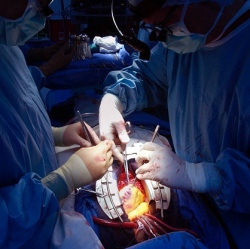
There’s a rule of thumb in surgery, the less invasive the procedure, the better. Less invasive surgeries reduce patient discomfort, foster faster recoveries, and limit the risk of infection. Problem is, you have to get your eyes on a problem to solve it. In heart surgery, practitioners use external ultrasound to view blockages.
The images are useful, but they are only good enough to serve as a general guide. Georgia Tech researchers, led by Professor F. Levent Degertekin, think they can improve the situation and even reduce the frequency of invasive heart surgery.
“If you’re a doctor, you want to see what is going on inside the arteries and inside the heart, but most of the devices being used for this today provide only cross-sectional images,” Degertekin says.
The group is building a tiny wired ultrasound device that surgeons can snake through arteries to provide a 3D, front-facing image of blockages in real time, the “equivalent of a flashlight” in the heart’s lightless passageways.
There are, of course, already internal ultrasound devices. These are used to image various organs, the stomach, for instance, by way of the esophagus. What makes this particular device special is its size and ability to travel into smaller pathways.
The device’s ultrasound transducers form a 1.5 millimeter ring around a hair-like guide wire. They send high frequency sound bursts ahead and listen for echoes. The signal is translated by a 1.4 millimeter silicon chip and sent out by wire where software constructs the image in real time and at higher resolution than external ultrasound.
